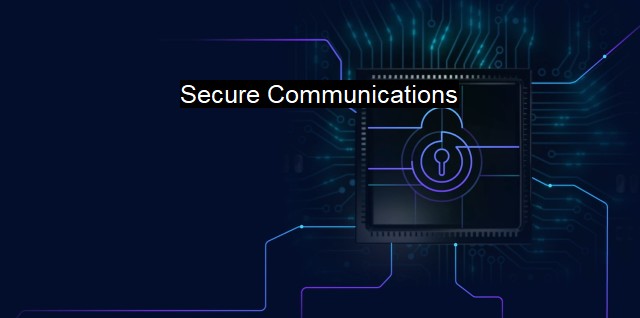What are Secure Communications?
The Importance of Consumer and Enterprise Communication Security in the Digital Age: Challenges and Solutions for Cybersecurity Experts
Secure communications refers to the methods, measures, and protocols employed to safeguard the transmission of sensitive information from unauthorized interception, tampering, or disruption. A fundamental concept secure communications is crucial in a world where interactions and transactions have increasingly migrated to the digital plane. It encapsulates the policies and procedures designed to safeguard data interchange and ensure the integrity, confidentiality, and accessibility of the transmitted information.The backbone of secure communication lies in encryption. Encryption cloaks the content of a message, transforming it into randomness or cipher-text which can only be read using the appropriate decryption key. Algorithms, the mathematical caveats, facilitate the encryption and decryption, and vary in complexity and reliability. Increasingly complex mathematical principles govern the most secure encryption methods, creating unassailable cipher-texts capable of withstanding even the most aggressive decryption efforts. Aside from encryption, secure communication often incorporates hashing techniques to confirm the integrity of a message. A hash function creates a unique hash value for every unique input; any alterations to the content would change the hash value, indicating possible tampering.
Protocols like Secure Sockets Layer (SSL), Transport Layer Security (TLS), and HyperText Transfer Protocol Secure (HTTPS) are fundamental to secure communication, and have become universally recognized benchmarks of a secure connection. These protocols encrypt data during transfer between a client and a server, ensuring that whether it's a financial transaction, a sensitive email, or user credentials, the data's integrity and confidentiality remain intact.
Secure communications also require foolproof verification of the parties involved in an information exchange. This ensures that sensitive information only goes to or comes from authenticated entities, warding off possibilities of spoofing, impersonations, or interceptions. Techniques include the use of cryptographic keys, digital signatures, digital certificates, and authorization referrals to authenticate the communicating entities.
The delicate nature of communications security has made intrusion detection systems, firewalls, and antivirus software indispensable elements of contemporary secure communication protocols. Intrusion detection systems monitor networks or systems for malicious activities or policy breaches, effectively offering a first line of defense against illicit intrusions. Firewalls then control incoming and outgoing network traffic by analyzing data packets and determining whether they should be allowed through or blocked.
Antivirus software plays an integral role, serving as a watchdog for any potentially malicious software that could undermine communication security protocols. Antivirus applications scan computer systems, identify viruses, spyware, or malware, and neutralize these threats to ensure data integrity and secure communications.
Despite these advanced methods, secure communication is persistently menaced by advanced hacking techniques, ingenious phishing exploits, relentless malware renditions, and rapid technological evolution. Cybersecurity professionals strive to keep pace, consistently seeking innovative protections for secure communications. Addressing these challenges requires an intricate mesh of advanced tools, watchful surveillance, and adaptive countermeasures, entwined with fluency in the language of algorithms, cryptology, and programming.
To encapsulate, secure communications entails more than seamless, high-speed connectivity—it's about ensuring that the authenticity of data remains uncompromised from the point of dispatch to receipt, that confidentiality is at the heart of every transmission, and that the availability and integrity of data sit at the very core of uninterrupted operations. As we tread further into this digital age, the role of secure communications in cybersecurity and antivirus efforts will only continue to expand, and its importance in safeguarding our interconnected world can't be overstated.

Secure Communications FAQs
What is secure communication in cybersecurity?
Secure communication refers to the exchange of information between two or more parties in a way that prevents unauthorized access or interception, ensuring confidentiality, integrity, and authenticity of the information.What are some common methods for secure communication in cybersecurity?
Some common methods for secure communication in cybersecurity include encryption, VPNs, two-factor authentication, and digital signatures.How does antivirus software help with secure communication?
Antivirus software helps with secure communication by detecting and removing malware and other malicious software that can compromise the integrity and confidentiality of communications. It can also protect against phishing attacks and other social engineering tactics that attackers use to gain access to sensitive information.Why is secure communication important in cybersecurity?
Secure communication is important in cybersecurity because it ensures that sensitive information is protected from unauthorized access, interception, and modification. It helps to prevent data breaches, identity theft, and other cyberattacks that can have serious consequences for individuals and organizations.| | A | | | B | | | C | | | D | | | E | | | F | | | G | | | H | | | I | | | J | | | K | | | L | | | M | |
| | N | | | O | | | P | | | Q | | | R | | | S | | | T | | | U | | | V | | | W | | | X | | | Y | | | Z | |
| | 1 | | | 2 | | | 3 | | | 4 | | | 7 | | | 8 | | |||||||